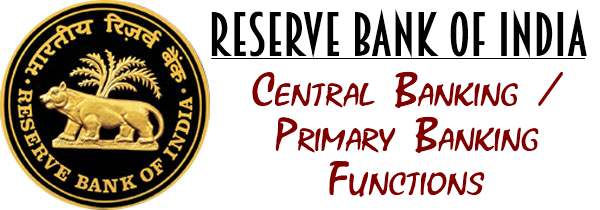Central Banking or Primary Functions of RBI
Central Banking Functions or Primary Functions of Reserve Bank of India (RBI)
The various primary functions of the Reserve Bank of India are described below:

Central Banking / Primary Functions
- Monopoly of note issue
- Banker’s bank and lender of the last resort
- Banker to Government
- Agent and advisor to the Government
- Regulation of foreign exchange
- Clearinghouses function
- Compilation of statistics
- Custodian of foreign exchange reserves
1. Monopoly of Note Issue
Section 22 of the Reserve Bank of India Act gives the Bank the sole right to issue bank notes as also the currency notes of the Government of India which may be supplied to it by the Government. The Bank issues on its own account bank notes of the denominations of Rs.2 and above. Ministry of Finance, Government of India issues one rupee notes. The Reserve Bank has a separate “Issue Department”, which is entrusted with the job of issuing currency notes.
According to the Reserve Bank of India Act, 1934, the proportional reserve system of note issue was required to be followed. As per the system, not less than 40% of the total note issue was required to be covered by gold and foreign securities. This system of note issue was in use. for more than 20. years. However, due to the need for increased money supply as well as foreign exchange reserves, the proportional reserve system of note issue was given up by amending the Reserve Bank of India Act in 1956.
2. Banker’s Bank and lender of last resort
Banks may be classified into scheduled banks and non-scheduled banks. A scheduled bank is one, which is included in the second schedule to the Reserve Bank of India Act. The inclusion of a bank in the second schedule does not guarantee the soundness and stability of the bank. So every scheduled bank is required to keep with the Reserve Bank a cash balance of not less than 3 percent of its total demand and time liabilities.
The Reserve Bank has the power to increase the cash reserves up to 15% of the total demand and time liabilities. These balances are kept with the Reserve Bank to enable it to exercise control over the credit that may be created by the commercial banks.
Every scheduled bank is also required to submit to the Reserve Bank every Friday a return containing details like the amount of its demand and time liabilities, its borrowings from banks in India, the total amount of legal tender notes and coins held by it in India, the balance held by it at the Reserve Bank and at other banks, its investments in Central and State Government securities including treasury bills and treasury deposit receipts, the amount of advances in India and the bills purchased and discounted in India.
The scheduled banks can borrow from the Reserve Bank on the basis of eligible securities by re-discounting their bills of exchange. The commercial banks can always approach the Reserve Bank for help. The Reserve Bank extends this help even when all the other banks in the money market have refused help. Hence the Reserve Bank is called as the lender of the last resort.
3. Banker to Government
The Reserve Bank of India acts as the banker to the Government, Central as well as States. As the banker to Government it performs the various functions, which are as follows:
1. It receives and makes payment on behalf of the Government.
2. It carries out their banking operations and exchange remittances.
3. It helps the Union and State Governments to float new loans and manage public debts.
4. It makes loans and advances to the States and local authorities.
5. It collects taxes on behalf of the Government.
6. It accepts deposits from the Government.
7. It collects cheques and drafts deposited in the Government accounts.
8. It provides short-teem loans and foreign exchange resources to the Government.
9. It also keeps the accounts of various Government Department.
10. It maintains currency chests in treasuries at some important places for the convenience of the Government.
Besides, the Reserve Bank of India extends ways and means advances to Central and State Governments. Ways and means advances is a system under which the Reserve Bank of India provides credit to Central and State Governments to meet temporary shortfall in Government revenues when compared to the monthly expenditures.
The maximum volume and period of such advances are governed by agreements between the Reserve Bank of India and the concerned Government. Various categories of ways and means advances, which the Reserve Bank of India grants to the State Governments, are:
1. Normal ways and means advances,
2. Special ways and means advances, and
3. Overdraft facility.
4. Agent and Advisor to Government
The Reserve Bank of India acts as advisor to Government on banking and financial matters and economic issues particularly in the field of resource mobilization and planning. It also advises on the matters of international finance.
5. Regulation of Foreign Exchange
The Reserve Bank is the custodian of India’s foreign exchange reserves. It maintains and stabilizes the external value of the rupee. It administers exchange. from authorized persons at rates of exchange fixed by the Government. It is also the responsibility of the Reserve Bank to maintain fixed exchange rates with all other member – countries of the international monetary fund.
Before 1992 all foreign exchange received or earned by residents in India should be surrendered to the banks, which have obtained license from the Reserve Bank of India to deal in foreign exchange. However, thereafter the receivers of foreign exchange are permitted to retain certain part of this foreign exchange in a separate foreign currency account known as Exchange Earned Foreign Currency Account if they so desire.
Since 1994 many controls exercised by the Reserve Bank of India on foreign exchange payments were relaxed. Nowadays the Reserve Bank of India regulates foreign exchange transactions only to a minimum level.
6. Clearing house Function
In India the Reserve Bank of India acts as the clearinghouse for scheduled banks, which have statutory accounts with it. Through this function the Reserve Bank of India enables the banks to settle their transactions among various banks easily and economically.
The Reserve Bank of India has its clearinghouse offices in 14 places in India. Some of the cities where it has its own clearinghouses are Mumbai, Bangalore, Kolkata, Chennai, Nagpur, Hyderabad, New Delhi, Patna and Kanpur. In other places, the clearinghouse function is carried out in the premises of SBI and its Associate Banks. At present 578 centers are run by SBI and its associate bankers.
7. Compilation of Statistics
The Reserve Bank of India collects data as to economic, financial, monetary and banking sectors of the economy. It keenly observes the trends of development in India and abroad. It conducts surveys for collecting statistics, studying problems as to currency and money supply, capital market, trade, Industry etc.
RBI analyses the budgets of State and Central Governments. It publishes periodically the reports regarding the operation of various banks. It publishes reports such as report on currency and finance; report on the trend and progress of banking in India. It computes India’s Balance of Payments statistics also.
8. Custodian of Foreign Exchange Reserves
Keeping sufficient foreign exchange reserves is necessary for maintaining foreign exchange rates. The Reserve Bank of India acts as the custodian of foreign exchange reserves. The Reserve Bank of India buys and sells foreign currencies not to make profit but to maintain stability in the foreign exchange rates. The value of foreign exchange reserves held by the Reserve Bank of India in April 2016 amounted to $359 billion (Source).

